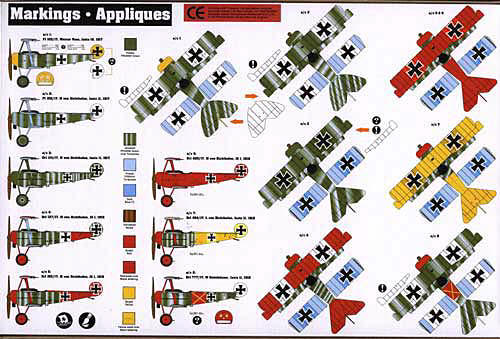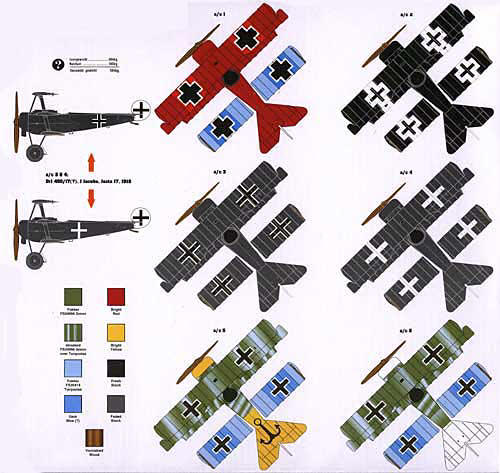|
Fokker F.I / Dr.I
“Early Aces”
Hobbycraft, 1/32 scale
S
u m m a r y
|
| Catalogue Number: |
Hobbycraft kit number H 1695 -
Fokker F.I / Dr.I “Early Aces” |
| Scale: |
1/32 |
| Contents and Media: |
Injection moulded plastic parts and decals |
| Price: |
USD$16.96
available online from Squadron.com |
| Review Type: |
FirstLook |
| Advantages: |
Optional parts supplied for different versions;
excellent decals |
| Disadvantages: |
Some possible fit challenges; simplified cockpit
detail; overstated fabric detail |
| Recommendation: |
Recommended |
Reviewed by
D.C. Shoemaker

Hobbycraft's
1/32 scale Fokker F.I / Dr.I "Early Aces"
is available online from Squadron
1/32 scale kits of World War I aircraft are not exactly thick on the
ground. Hobbycraft began with the first-class Nieuport 17 (in several
versions, identical but for the decals) and followed with two SPAD XIII
kits, again identical but for markings. Now their long-rumored 1/32
scale Fokker Triplane kit has finally arrived, in the form of two kits,
H 695 “Early Aces” and H 698 “Late Aces.” The main difference between
the two again lies in the decal sheets, discussed below.
The box is larger than expected; another mold-maker, this time in
China, is now involved. A first look in the box was encouraging; for
instance, the stabilizers are correct, not curiously stepped as in the
Roden kit. However, closer inspection reveals some subtle (and not so
subtle) problems. It’s a truism in this business that there’s no perfect
kit, and overall Hobbycraft has done well, but there are some odd
lapses. For instance, after years of packaging the old Revell 1/28
Triplane, and exemplary kit for its time, it’s odd that the kit’s
designers overstated the wing rib/rib tape detail to so great an extent.
Some sanding, possibly with some filling, will reduce the problem.
The fit of some parts, notably the interplane struts and cockpit braces,
will require some trimming. If you wish to do an F.I (without the wing
skids) the skid mounting holes will need filling.
That said, all else is praiseworthy. The builder is given the choice of
early (F.I) stabilizer, elevators and ailerons, and most remarkably, the
correct early engine cowling. Many modelers may not know that at various
times, Fokker used three different cowls. The first is the most common,
made of several pieces with the front plate riveted to the curved cowl;
this is the one most often seen in photographs. The early versions of
this cowling, as used on the F.I, had this lower lip removed for the
later versions; the instructions show how to do this. The third version
appears in only a few photographs and seems to be a one-piece spun or
pressed aluminum cowling with no separate front plate. This is the cowl
chosen by Roden for their kit, which resulted in some criticism for
getting it wrong. (It probably is wrong on their Fokker D VI, which
shares the Dr.I cowling, but that’s another story.)
As in the Roden kit, you have the choice of early or late ailerons and
tails, as mentioned. This means that both Von Richtofen’s and Voss’
earliest aircraft can now easily be done, and Hobbycraft is to be
congratulated for that. Some builders may be unaware that early DrI
batches had a port aileron with a greater area than that of the
starboard, and Hobbycraft caters to that, too. It was apparently felt
that the Triplane’s turn to the right could be improved if the left
aileron had a greater area. (Why anyone would want to do this I can’t
imagine; it was a vicious right-handed machine already, due to the short
wingspan and high inertia of the rotary engine. Some people just can’t
get enough of a good thing, I suppose.)
Cockpit detail is a bit simpler than Roden’s, but satisfactory, and the
modeler can certainly add detail such as seatbelts, gunsights and the
like. Hobbycraft also provides a telescopic sight (which MvR may or may
not have used.) Engine detail is satisfactory, and the same two
propeller types as in the Roden kit are provided. The “straight” one is
the standard German Axial prop most commonly seen, but the other is the
French-style “curved” blade used with the Le Rhône engines. This would
make it easy to fit a Le Rhône engine from Hobbycraft’s Nieuport 17
exactly as many German pilots did; the Le Rhône was felt by many to be
more reliable than the Uberursel II normally provided. And if they had a
choice, they used the French propeller. Some sources suggest the German
propellor manufacturers also produced this style prop.
The Decals
Both kits come with excellent sheets, but marking descriptions are
limited, and the careful builder will want to check some other
references for details.

Figure 1. Decal options accompanying H 1695 “Early
Aces.”
Rittmeister (Cavalry Captain) Manfred Freiherr von Richtofen features
heavily, and as the most famous exponent of this most famous of all
German World War I aircraft this is appropriate. However, Hobbycraft has
provided markings no less than eight aircraft on the first sheet,
including Werner Voss and MvR’s brother Lothar, and six more aircraft on
the second. Together with the two excellent Fokker Dr.I sheets from
Cutting Edge, you have plenty of scope, and more will doubtless follow.

Figure 2. Decal options accompanying H 1698, “Late
Aces.”
Comparisons
Discussions of the differences between the Roden and Hobbycraft kits
are inevitable. The former is in many respects the better, although it
has its problems. This is not surprising, in view of the fact that
Roden’s kit is nearly twice the cost of Hobbycraft’s. Roden has a
strange shape to the top of their stabilizers, which Hobbycraft does
not. Hobbycraft provides the more common engine cowling, but a simpler
engine and cockpit. Roden gives two sets of markings, and Hobbycraft
eight. Both provide the alternative ailerons, tails and propellers,
although neither explain why. Roden’s instruction sheet is possibly
superior to Hobbycraft’s. Curiously, Hobbycraft bills their kit as Level
4, which generally implies resin or brass components, which it has not
got. It seems to me that the Hobbycraft kit might be easier for the
World War I novice, however.
Hobbycraft’s 1/32 scale Fokker Dr.I is not in quite the same league as
their SPAD XIII, but at $19.95 is still good value for money. And their
decal sheet is first-rate in all respects.
Given the range of MvR aircraft on Hobbycraft’s sheet, a modeler can
save the $15.00 of the Cutting Edge sheets and turn out an impressive
kit. Add some foil seatbelts and call it finished. Replacing the
Uberursel with a Le Rhône engine, fitting the curved prop, and using
asymmetrical ailerons gives the builder a change to create a Dr.I very
different from the run-of-the-mill Triplanes we’ve all seen a hundred
times. Build one and see how long it takes someone to notice the
differences.
In fact, with engine, cowling aileron and tail variations, you could
build four or five different versions and, at this price, you can afford
to.
Recommended.
Review and Images Copyright © 2006 by
D.C. Shoemaker
Page Created 31 March, 2006
Last updated 30 March, 2006
Back to HyperScale Main Page
Back to Reviews Page
|
Home | What's
New | Features
| Gallery |
Reviews | Reference
| Forum
| Search